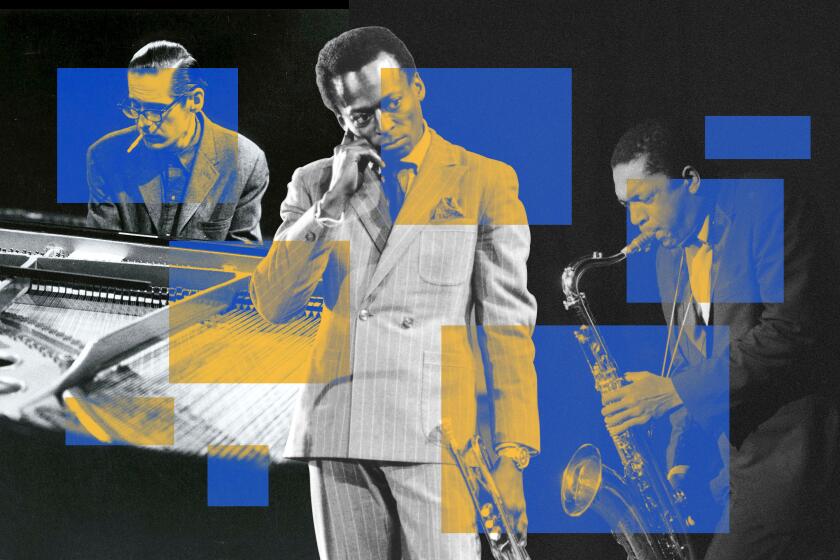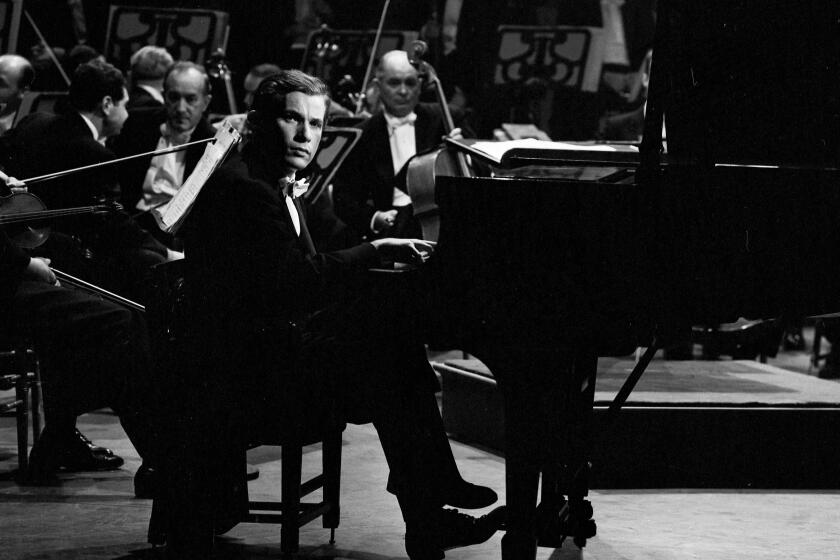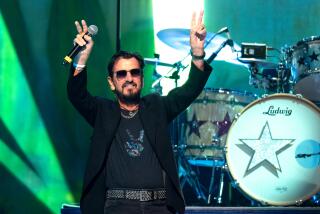Opinion: For the greats of the jazz age, life on the road was perilous as well as glamorous

For traveling musicians, there are two versions of life on the road.
Jazz greats Duke Ellington, Count Basie and Louis Armstrong gave their own sentimentalized retelling of their nomadic existence from the 1930s onward, portraying the jaunts as being as amorous as they were glamorous, a veritable luxury cruise along bucolic byways jammed with adulatory fans and a femme fatale or two.
James Kaplan’s triple biography weaves together ‘3 Shades of Blue’ in the backstories of Miles Davis, John Coltrane and Bill Evans at the height of jazz’s cultural sway.
Much of that might have been true, but they were also living the other version of the wayfaring life. Those trips, often through hostile territory, were a harsh crucible, keeping Ellington, Basie and Armstrong away from home and family for lonely months at a time. They became professional wanderers, driving all day, performing into the early morning, learning to eat from greasy paper sacks. On bad nights for the bandleaders and their players, they caught a little sleep on the bus or in the car, scrunched between sweaty orchestra mates. On good ones, they found a lodging house and raced upstairs, hoping to claim a catnap before that evening’s gig. The more savvy veterans would leave the lights on to keep the cockroaches and bedbugs in their crevices. Layering newspapers atop the mattress was another trick; the crinkling sent the vermin scampering.
Peeling back those curtains can be enlightening because the three jazzmen from last century helped set the template for today’s migratory music makers, be they Taylor Swift or Beyoncé. Whatever the reality of their days and nights on the road, Ellington, Basie and Armstrong built the expectation that touring is all about luxe accommodations and fat paychecks. Looking into that tuneful past — on the occasion of Duke’s 125th birthday and the Count’s 120th, as we approach the centennial of Satchmo’s genre-defining Hot Five recordings — helps us not just separate myth from reality but also appreciate ways in which our world has gotten better.
Glenn Gould was the most famous concert pianist of his time. When he gave up public performing, everything about recording changed
The biggest change since their era? The hostile terrain that Jim Crow America created even for the nation’s most venerated Black travelers. Accidentally picking a whites-only hotel or eatery could land a band member in jail or worse.
Their journeys attuned these three orchestra leaders to the subtleties and unsubtleties of America’s color lines. No dining in Chicago’s Loop. No entry at night, and sometimes at all, into Goshen, Ind., La Crosse, Wis., and thousands of other “sundown towns.” And don’t mention the Civil War below the Mason-Dixon line, because down there it was still called the War of Northern Aggression. When Black musicians pulled up, sometimes gas station owners locked their restrooms. Other times the swimming pool at their motel was drained just as they arrived and refilled as they were leaving.
Ellington, Basie and Armstrong successfully navigated that perilous world, and these self-described gadabouts got to see this vast country in a way few Americans, and almost no Black Americans, did then. Hundreds of white fans who had never seen a Black person turned out in farming villages and mining towns — and boy, what an encounter it was on both ends. The farmers and miners got to hear the most intoxicating music on Earth from brassy cornet players and driving saxophonists, exotic trombone mutes, squealing trumpets and sultry clarinets. The musicians, meanwhile, were doing what they loved, being treated like celebrities in ways that shaped the mold for the likes of last year’s Eras and Renaissance tours.
One night in particular captured the joy Count Basie felt on the road, in circumstances that would have unsettled less determined performers. His band rolled into the lakefront burg of Manitowoc, Wis., the heart of Green Bay Packers country, on a night in 1972 when the Packers were facing off against the Detroit Lions. A TV set broadcast the gridiron action from one end of the venue while at the other end the band sat morosely, doubting they could compete for attention. Basie merely leaned forward and ordered, “Play.” For an hour he gave the football-mad audience his best and, little by little, fans headed across the large hall toward the music. Then they called friends to join them. Near the end of the evening the host borrowed the microphone to announce that the Packers had won. There was a polite cheer, then someone yelled, “How ’bout ‘April in Paris’ again?” Basie smiled, whispering, “Touchdown.”
Among African Americans, only the Pullman porters saw more of America, and even they just rolled through places like Fargo, N.D. But Ellington stayed on one winter night in 1940 for a concert at the Crystal Ballroom that drew about 700 fans who, for the price of $1.30, got to hear the orchestra hitting on all cylinders. The population of North Dakota was only 0.03% Black then, and so perhaps racism wasn’t as all-consuming as in other parts of the country. There was no TV to take people’s minds off the raging war, little money for the motion pictures, not much else to do in a city that celebrated its political and cultural isolation. That left jazz.
To Duke, the Count and Satchmo, music meant movement, and their freedom to roam was more liberating than a running back breaking into the clear.
Larry Tye is the author of “The Jazzmen: How Duke Ellington, Louis Armstrong and Count Basie Transformed America.”
More to Read
A cure for the common opinion
Get thought-provoking perspectives with our weekly newsletter.
You may occasionally receive promotional content from the Los Angeles Times.












